MKT303A - R.M. Williams: Strategic Market Analysis - Europe and China
VerifiedAdded on 2023/05/29
|11
|2843
|209
Case Study
AI Summary
This case study provides a comparative analysis of the European and Chinese markets for the Australian brand R.M. Williams, now owned by LVMH. It assesses the economic, financial, political, legal, and cultural environments in both regions, evaluating their potential for immediate market development. The analysis considers factors such as GDP growth, investment climate, regulatory frameworks, and cultural nuances, drawing on relevant statistics and frameworks. Strategic recommendations are offered, weighing the opportunities and challenges presented by each market to guide R.M. Williams' international expansion strategy. The study concludes that China offers more immediate benefits due to its strong economic growth, protective measures for investors, and a culture that embraces other cultures.
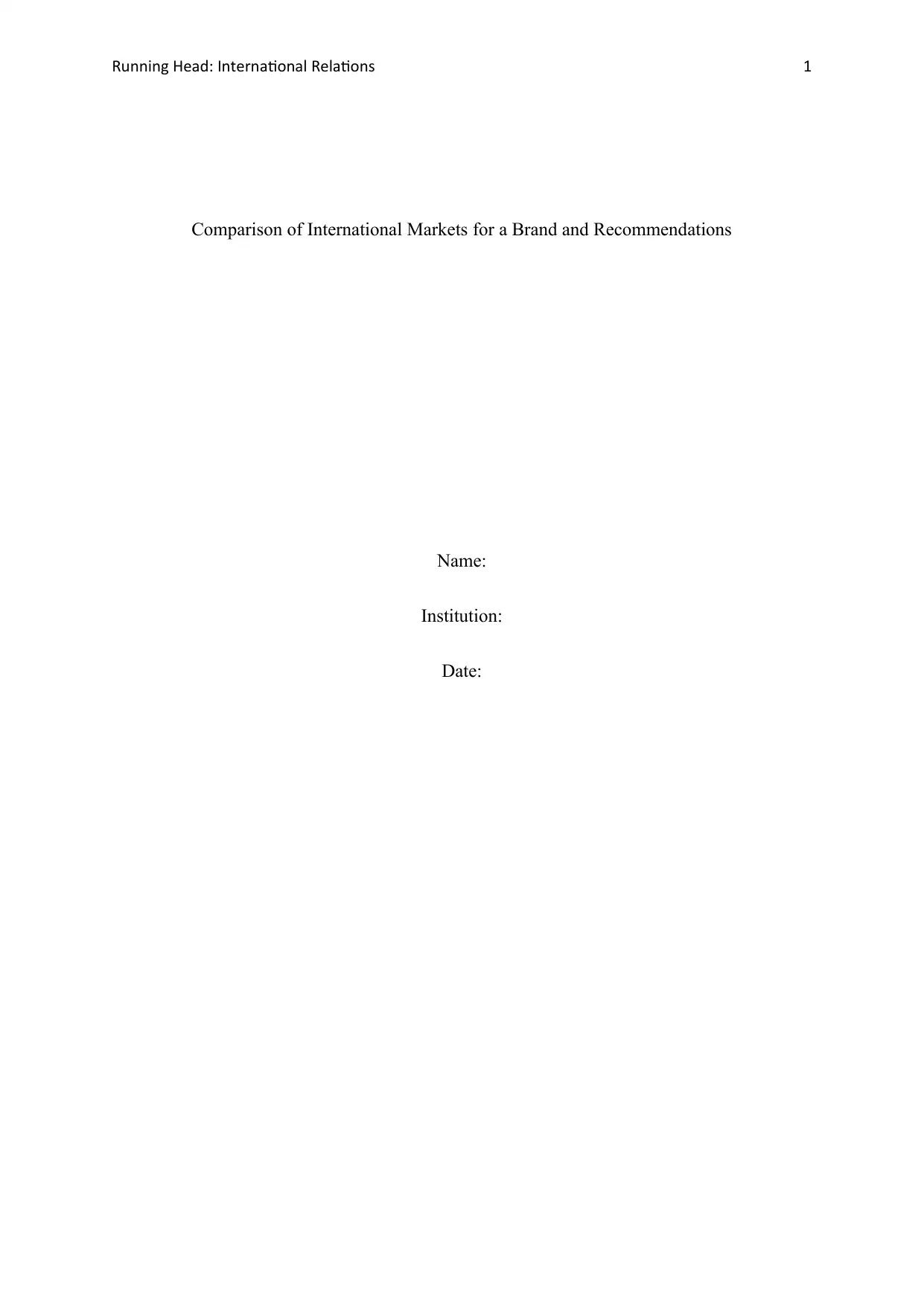
Running Head: International Relations 1
Comparison of International Markets for a Brand and Recommendations
Name:
Institution:
Date:
Comparison of International Markets for a Brand and Recommendations
Name:
Institution:
Date:
Paraphrase This Document
Need a fresh take? Get an instant paraphrase of this document with our AI Paraphraser
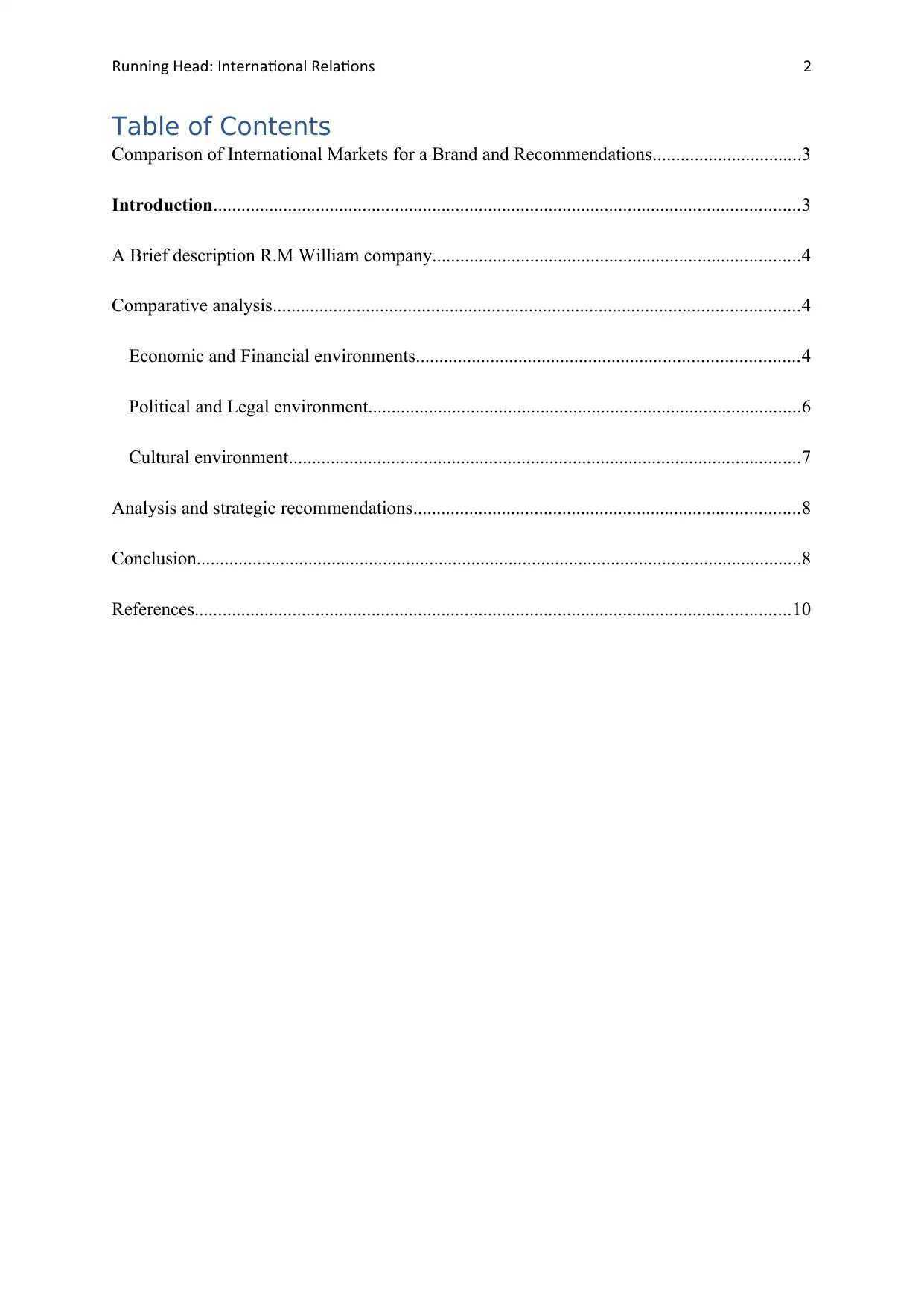
Running Head: International Relations 2
Table of Contents
Comparison of International Markets for a Brand and Recommendations................................3
Introduction..............................................................................................................................3
A Brief description R.M William company...............................................................................4
Comparative analysis.................................................................................................................4
Economic and Financial environments..................................................................................4
Political and Legal environment.............................................................................................6
Cultural environment..............................................................................................................7
Analysis and strategic recommendations...................................................................................8
Conclusion..................................................................................................................................8
References................................................................................................................................10
Table of Contents
Comparison of International Markets for a Brand and Recommendations................................3
Introduction..............................................................................................................................3
A Brief description R.M William company...............................................................................4
Comparative analysis.................................................................................................................4
Economic and Financial environments..................................................................................4
Political and Legal environment.............................................................................................6
Cultural environment..............................................................................................................7
Analysis and strategic recommendations...................................................................................8
Conclusion..................................................................................................................................8
References................................................................................................................................10
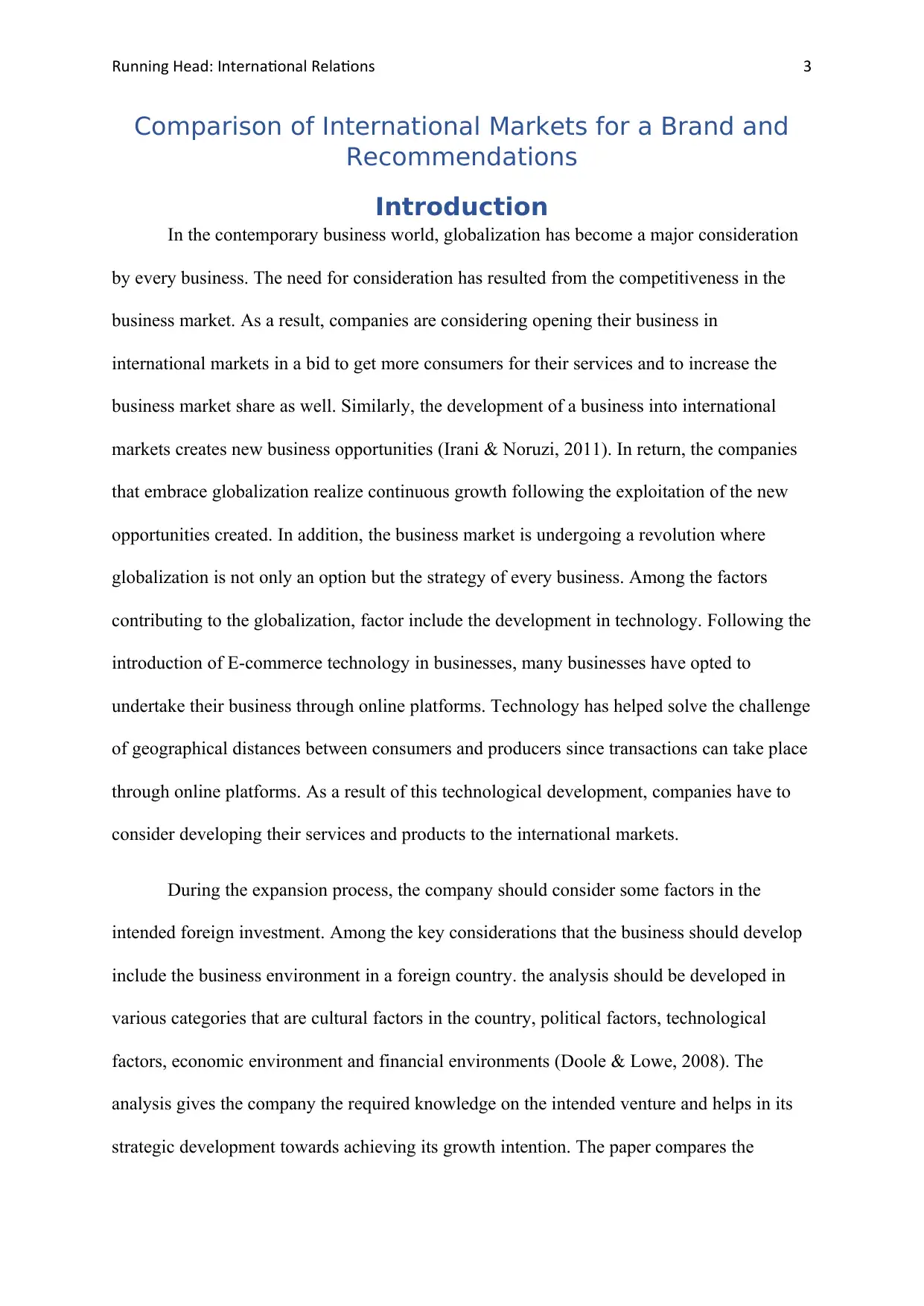
Running Head: International Relations 3
Comparison of International Markets for a Brand and
Recommendations
Introduction
In the contemporary business world, globalization has become a major consideration
by every business. The need for consideration has resulted from the competitiveness in the
business market. As a result, companies are considering opening their business in
international markets in a bid to get more consumers for their services and to increase the
business market share as well. Similarly, the development of a business into international
markets creates new business opportunities (Irani & Noruzi, 2011). In return, the companies
that embrace globalization realize continuous growth following the exploitation of the new
opportunities created. In addition, the business market is undergoing a revolution where
globalization is not only an option but the strategy of every business. Among the factors
contributing to the globalization, factor include the development in technology. Following the
introduction of E-commerce technology in businesses, many businesses have opted to
undertake their business through online platforms. Technology has helped solve the challenge
of geographical distances between consumers and producers since transactions can take place
through online platforms. As a result of this technological development, companies have to
consider developing their services and products to the international markets.
During the expansion process, the company should consider some factors in the
intended foreign investment. Among the key considerations that the business should develop
include the business environment in a foreign country. the analysis should be developed in
various categories that are cultural factors in the country, political factors, technological
factors, economic environment and financial environments (Doole & Lowe, 2008). The
analysis gives the company the required knowledge on the intended venture and helps in its
strategic development towards achieving its growth intention. The paper compares the
Comparison of International Markets for a Brand and
Recommendations
Introduction
In the contemporary business world, globalization has become a major consideration
by every business. The need for consideration has resulted from the competitiveness in the
business market. As a result, companies are considering opening their business in
international markets in a bid to get more consumers for their services and to increase the
business market share as well. Similarly, the development of a business into international
markets creates new business opportunities (Irani & Noruzi, 2011). In return, the companies
that embrace globalization realize continuous growth following the exploitation of the new
opportunities created. In addition, the business market is undergoing a revolution where
globalization is not only an option but the strategy of every business. Among the factors
contributing to the globalization, factor include the development in technology. Following the
introduction of E-commerce technology in businesses, many businesses have opted to
undertake their business through online platforms. Technology has helped solve the challenge
of geographical distances between consumers and producers since transactions can take place
through online platforms. As a result of this technological development, companies have to
consider developing their services and products to the international markets.
During the expansion process, the company should consider some factors in the
intended foreign investment. Among the key considerations that the business should develop
include the business environment in a foreign country. the analysis should be developed in
various categories that are cultural factors in the country, political factors, technological
factors, economic environment and financial environments (Doole & Lowe, 2008). The
analysis gives the company the required knowledge on the intended venture and helps in its
strategic development towards achieving its growth intention. The paper compares the
⊘ This is a preview!⊘
Do you want full access?
Subscribe today to unlock all pages.

Trusted by 1+ million students worldwide
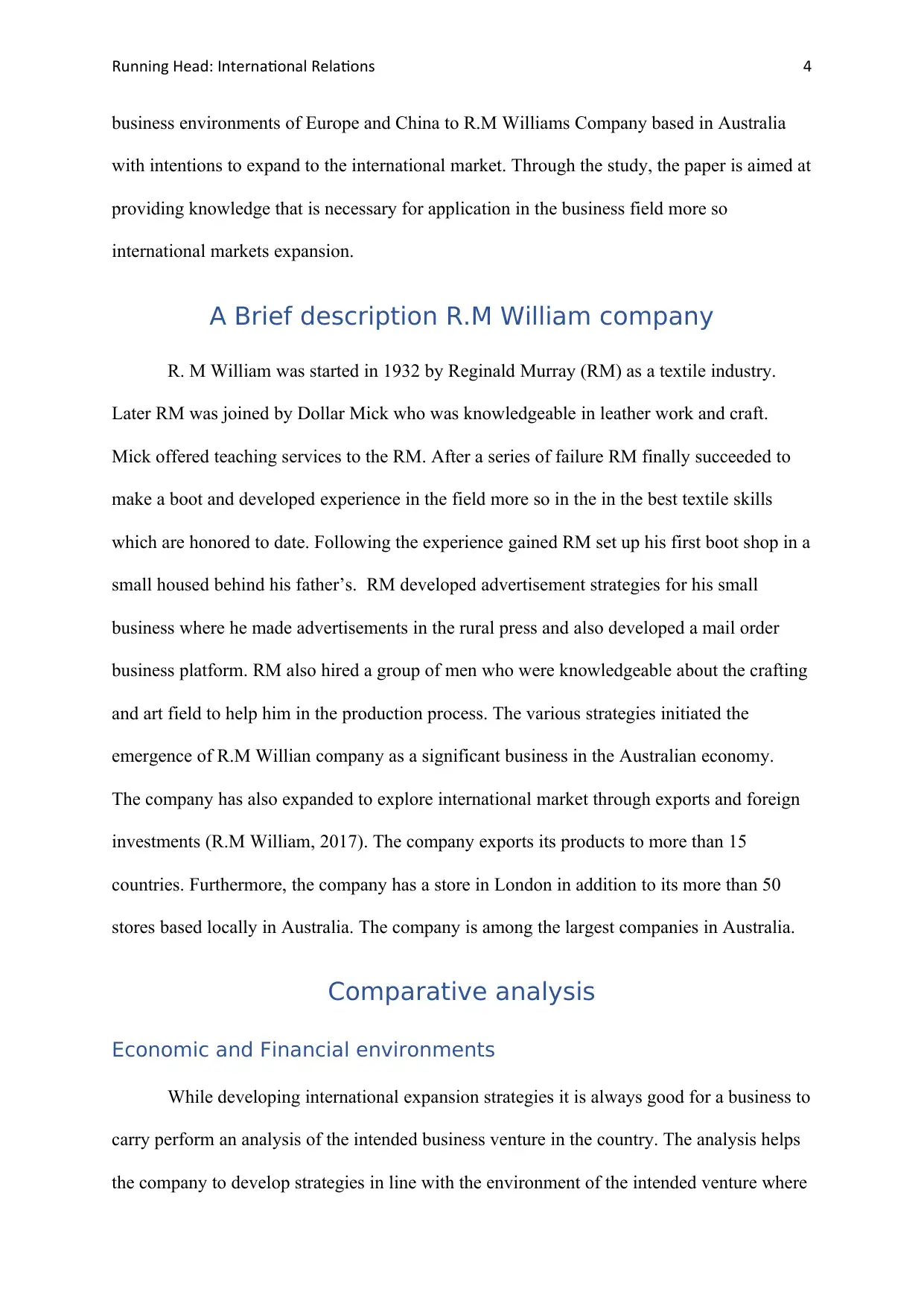
Running Head: International Relations 4
business environments of Europe and China to R.M Williams Company based in Australia
with intentions to expand to the international market. Through the study, the paper is aimed at
providing knowledge that is necessary for application in the business field more so
international markets expansion.
A Brief description R.M William company
R. M William was started in 1932 by Reginald Murray (RM) as a textile industry.
Later RM was joined by Dollar Mick who was knowledgeable in leather work and craft.
Mick offered teaching services to the RM. After a series of failure RM finally succeeded to
make a boot and developed experience in the field more so in the in the best textile skills
which are honored to date. Following the experience gained RM set up his first boot shop in a
small housed behind his father’s. RM developed advertisement strategies for his small
business where he made advertisements in the rural press and also developed a mail order
business platform. RM also hired a group of men who were knowledgeable about the crafting
and art field to help him in the production process. The various strategies initiated the
emergence of R.M Willian company as a significant business in the Australian economy.
The company has also expanded to explore international market through exports and foreign
investments (R.M William, 2017). The company exports its products to more than 15
countries. Furthermore, the company has a store in London in addition to its more than 50
stores based locally in Australia. The company is among the largest companies in Australia.
Comparative analysis
Economic and Financial environments
While developing international expansion strategies it is always good for a business to
carry perform an analysis of the intended business venture in the country. The analysis helps
the company to develop strategies in line with the environment of the intended venture where
business environments of Europe and China to R.M Williams Company based in Australia
with intentions to expand to the international market. Through the study, the paper is aimed at
providing knowledge that is necessary for application in the business field more so
international markets expansion.
A Brief description R.M William company
R. M William was started in 1932 by Reginald Murray (RM) as a textile industry.
Later RM was joined by Dollar Mick who was knowledgeable in leather work and craft.
Mick offered teaching services to the RM. After a series of failure RM finally succeeded to
make a boot and developed experience in the field more so in the in the best textile skills
which are honored to date. Following the experience gained RM set up his first boot shop in a
small housed behind his father’s. RM developed advertisement strategies for his small
business where he made advertisements in the rural press and also developed a mail order
business platform. RM also hired a group of men who were knowledgeable about the crafting
and art field to help him in the production process. The various strategies initiated the
emergence of R.M Willian company as a significant business in the Australian economy.
The company has also expanded to explore international market through exports and foreign
investments (R.M William, 2017). The company exports its products to more than 15
countries. Furthermore, the company has a store in London in addition to its more than 50
stores based locally in Australia. The company is among the largest companies in Australia.
Comparative analysis
Economic and Financial environments
While developing international expansion strategies it is always good for a business to
carry perform an analysis of the intended business venture in the country. The analysis helps
the company to develop strategies in line with the environment of the intended venture where
Paraphrase This Document
Need a fresh take? Get an instant paraphrase of this document with our AI Paraphraser
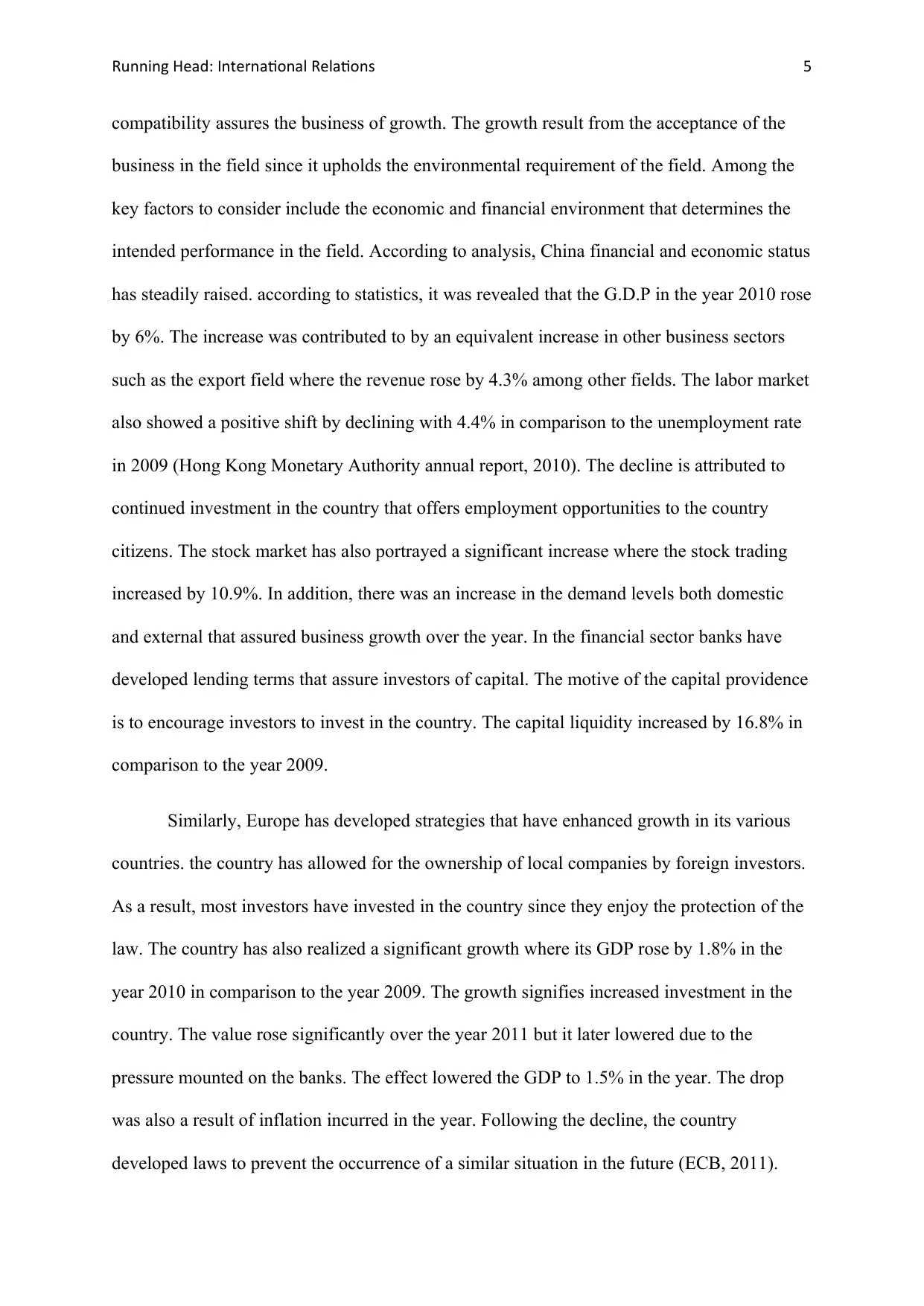
Running Head: International Relations 5
compatibility assures the business of growth. The growth result from the acceptance of the
business in the field since it upholds the environmental requirement of the field. Among the
key factors to consider include the economic and financial environment that determines the
intended performance in the field. According to analysis, China financial and economic status
has steadily raised. according to statistics, it was revealed that the G.D.P in the year 2010 rose
by 6%. The increase was contributed to by an equivalent increase in other business sectors
such as the export field where the revenue rose by 4.3% among other fields. The labor market
also showed a positive shift by declining with 4.4% in comparison to the unemployment rate
in 2009 (Hong Kong Monetary Authority annual report, 2010). The decline is attributed to
continued investment in the country that offers employment opportunities to the country
citizens. The stock market has also portrayed a significant increase where the stock trading
increased by 10.9%. In addition, there was an increase in the demand levels both domestic
and external that assured business growth over the year. In the financial sector banks have
developed lending terms that assure investors of capital. The motive of the capital providence
is to encourage investors to invest in the country. The capital liquidity increased by 16.8% in
comparison to the year 2009.
Similarly, Europe has developed strategies that have enhanced growth in its various
countries. the country has allowed for the ownership of local companies by foreign investors.
As a result, most investors have invested in the country since they enjoy the protection of the
law. The country has also realized a significant growth where its GDP rose by 1.8% in the
year 2010 in comparison to the year 2009. The growth signifies increased investment in the
country. The value rose significantly over the year 2011 but it later lowered due to the
pressure mounted on the banks. The effect lowered the GDP to 1.5% in the year. The drop
was also a result of inflation incurred in the year. Following the decline, the country
developed laws to prevent the occurrence of a similar situation in the future (ECB, 2011).
compatibility assures the business of growth. The growth result from the acceptance of the
business in the field since it upholds the environmental requirement of the field. Among the
key factors to consider include the economic and financial environment that determines the
intended performance in the field. According to analysis, China financial and economic status
has steadily raised. according to statistics, it was revealed that the G.D.P in the year 2010 rose
by 6%. The increase was contributed to by an equivalent increase in other business sectors
such as the export field where the revenue rose by 4.3% among other fields. The labor market
also showed a positive shift by declining with 4.4% in comparison to the unemployment rate
in 2009 (Hong Kong Monetary Authority annual report, 2010). The decline is attributed to
continued investment in the country that offers employment opportunities to the country
citizens. The stock market has also portrayed a significant increase where the stock trading
increased by 10.9%. In addition, there was an increase in the demand levels both domestic
and external that assured business growth over the year. In the financial sector banks have
developed lending terms that assure investors of capital. The motive of the capital providence
is to encourage investors to invest in the country. The capital liquidity increased by 16.8% in
comparison to the year 2009.
Similarly, Europe has developed strategies that have enhanced growth in its various
countries. the country has allowed for the ownership of local companies by foreign investors.
As a result, most investors have invested in the country since they enjoy the protection of the
law. The country has also realized a significant growth where its GDP rose by 1.8% in the
year 2010 in comparison to the year 2009. The growth signifies increased investment in the
country. The value rose significantly over the year 2011 but it later lowered due to the
pressure mounted on the banks. The effect lowered the GDP to 1.5% in the year. The drop
was also a result of inflation incurred in the year. Following the decline, the country
developed laws to prevent the occurrence of a similar situation in the future (ECB, 2011).
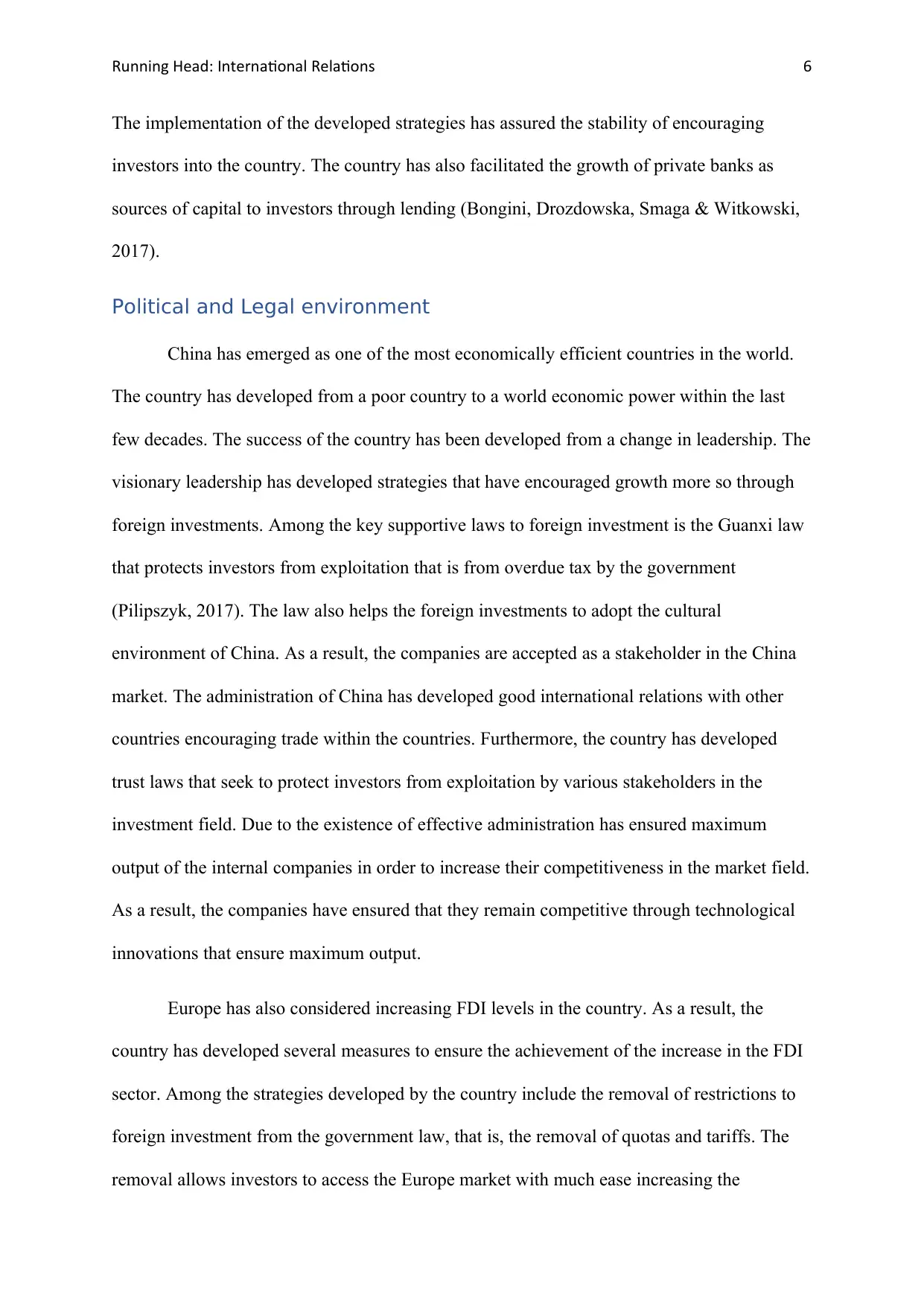
Running Head: International Relations 6
The implementation of the developed strategies has assured the stability of encouraging
investors into the country. The country has also facilitated the growth of private banks as
sources of capital to investors through lending (Bongini, Drozdowska, Smaga & Witkowski,
2017).
Political and Legal environment
China has emerged as one of the most economically efficient countries in the world.
The country has developed from a poor country to a world economic power within the last
few decades. The success of the country has been developed from a change in leadership. The
visionary leadership has developed strategies that have encouraged growth more so through
foreign investments. Among the key supportive laws to foreign investment is the Guanxi law
that protects investors from exploitation that is from overdue tax by the government
(Pilipszyk, 2017). The law also helps the foreign investments to adopt the cultural
environment of China. As a result, the companies are accepted as a stakeholder in the China
market. The administration of China has developed good international relations with other
countries encouraging trade within the countries. Furthermore, the country has developed
trust laws that seek to protect investors from exploitation by various stakeholders in the
investment field. Due to the existence of effective administration has ensured maximum
output of the internal companies in order to increase their competitiveness in the market field.
As a result, the companies have ensured that they remain competitive through technological
innovations that ensure maximum output.
Europe has also considered increasing FDI levels in the country. As a result, the
country has developed several measures to ensure the achievement of the increase in the FDI
sector. Among the strategies developed by the country include the removal of restrictions to
foreign investment from the government law, that is, the removal of quotas and tariffs. The
removal allows investors to access the Europe market with much ease increasing the
The implementation of the developed strategies has assured the stability of encouraging
investors into the country. The country has also facilitated the growth of private banks as
sources of capital to investors through lending (Bongini, Drozdowska, Smaga & Witkowski,
2017).
Political and Legal environment
China has emerged as one of the most economically efficient countries in the world.
The country has developed from a poor country to a world economic power within the last
few decades. The success of the country has been developed from a change in leadership. The
visionary leadership has developed strategies that have encouraged growth more so through
foreign investments. Among the key supportive laws to foreign investment is the Guanxi law
that protects investors from exploitation that is from overdue tax by the government
(Pilipszyk, 2017). The law also helps the foreign investments to adopt the cultural
environment of China. As a result, the companies are accepted as a stakeholder in the China
market. The administration of China has developed good international relations with other
countries encouraging trade within the countries. Furthermore, the country has developed
trust laws that seek to protect investors from exploitation by various stakeholders in the
investment field. Due to the existence of effective administration has ensured maximum
output of the internal companies in order to increase their competitiveness in the market field.
As a result, the companies have ensured that they remain competitive through technological
innovations that ensure maximum output.
Europe has also considered increasing FDI levels in the country. As a result, the
country has developed several measures to ensure the achievement of the increase in the FDI
sector. Among the strategies developed by the country include the removal of restrictions to
foreign investment from the government law, that is, the removal of quotas and tariffs. The
removal allows investors to access the Europe market with much ease increasing the
⊘ This is a preview!⊘
Do you want full access?
Subscribe today to unlock all pages.

Trusted by 1+ million students worldwide
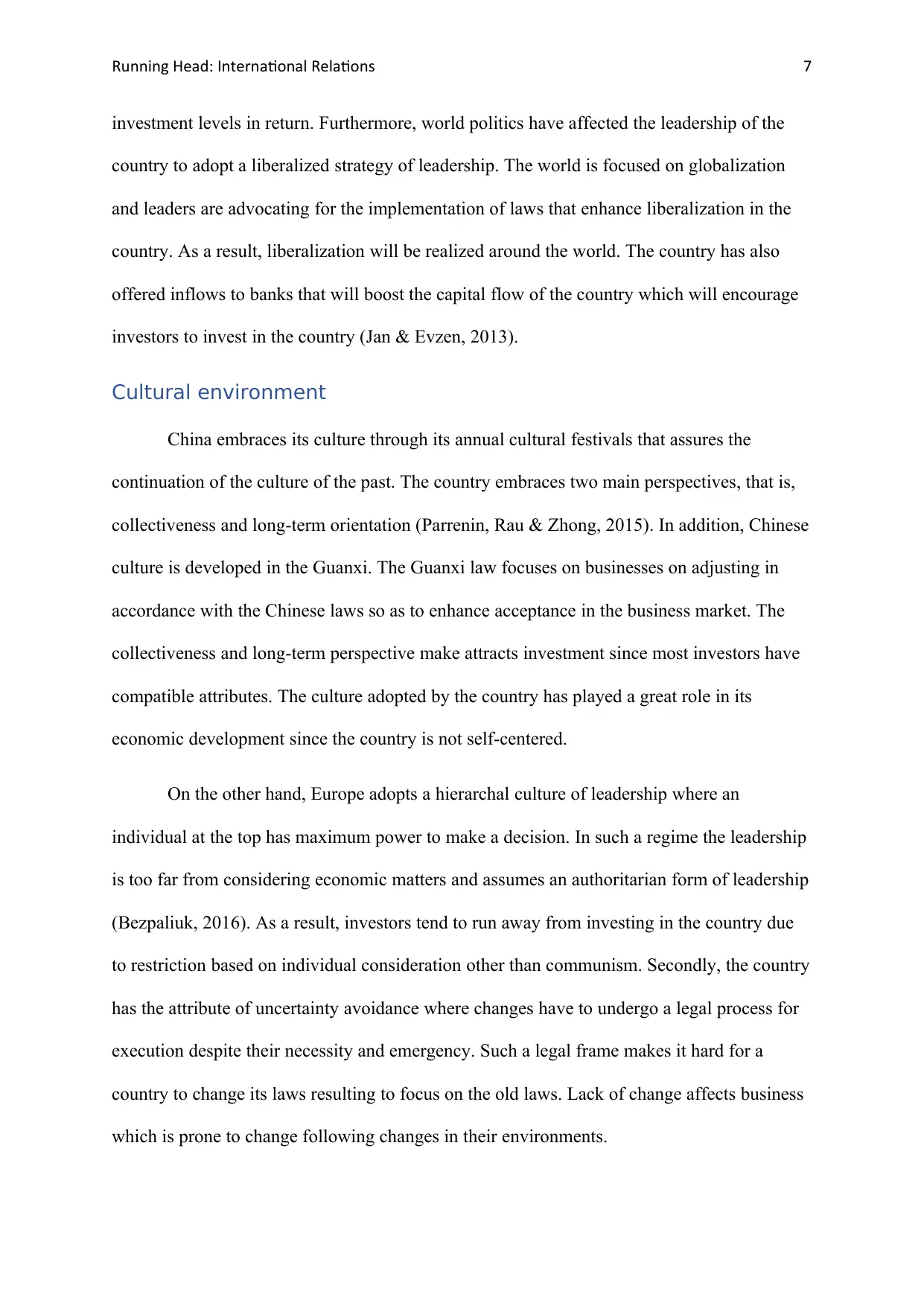
Running Head: International Relations 7
investment levels in return. Furthermore, world politics have affected the leadership of the
country to adopt a liberalized strategy of leadership. The world is focused on globalization
and leaders are advocating for the implementation of laws that enhance liberalization in the
country. As a result, liberalization will be realized around the world. The country has also
offered inflows to banks that will boost the capital flow of the country which will encourage
investors to invest in the country (Jan & Evzen, 2013).
Cultural environment
China embraces its culture through its annual cultural festivals that assures the
continuation of the culture of the past. The country embraces two main perspectives, that is,
collectiveness and long-term orientation (Parrenin, Rau & Zhong, 2015). In addition, Chinese
culture is developed in the Guanxi. The Guanxi law focuses on businesses on adjusting in
accordance with the Chinese laws so as to enhance acceptance in the business market. The
collectiveness and long-term perspective make attracts investment since most investors have
compatible attributes. The culture adopted by the country has played a great role in its
economic development since the country is not self-centered.
On the other hand, Europe adopts a hierarchal culture of leadership where an
individual at the top has maximum power to make a decision. In such a regime the leadership
is too far from considering economic matters and assumes an authoritarian form of leadership
(Bezpaliuk, 2016). As a result, investors tend to run away from investing in the country due
to restriction based on individual consideration other than communism. Secondly, the country
has the attribute of uncertainty avoidance where changes have to undergo a legal process for
execution despite their necessity and emergency. Such a legal frame makes it hard for a
country to change its laws resulting to focus on the old laws. Lack of change affects business
which is prone to change following changes in their environments.
investment levels in return. Furthermore, world politics have affected the leadership of the
country to adopt a liberalized strategy of leadership. The world is focused on globalization
and leaders are advocating for the implementation of laws that enhance liberalization in the
country. As a result, liberalization will be realized around the world. The country has also
offered inflows to banks that will boost the capital flow of the country which will encourage
investors to invest in the country (Jan & Evzen, 2013).
Cultural environment
China embraces its culture through its annual cultural festivals that assures the
continuation of the culture of the past. The country embraces two main perspectives, that is,
collectiveness and long-term orientation (Parrenin, Rau & Zhong, 2015). In addition, Chinese
culture is developed in the Guanxi. The Guanxi law focuses on businesses on adjusting in
accordance with the Chinese laws so as to enhance acceptance in the business market. The
collectiveness and long-term perspective make attracts investment since most investors have
compatible attributes. The culture adopted by the country has played a great role in its
economic development since the country is not self-centered.
On the other hand, Europe adopts a hierarchal culture of leadership where an
individual at the top has maximum power to make a decision. In such a regime the leadership
is too far from considering economic matters and assumes an authoritarian form of leadership
(Bezpaliuk, 2016). As a result, investors tend to run away from investing in the country due
to restriction based on individual consideration other than communism. Secondly, the country
has the attribute of uncertainty avoidance where changes have to undergo a legal process for
execution despite their necessity and emergency. Such a legal frame makes it hard for a
country to change its laws resulting to focus on the old laws. Lack of change affects business
which is prone to change following changes in their environments.
Paraphrase This Document
Need a fresh take? Get an instant paraphrase of this document with our AI Paraphraser
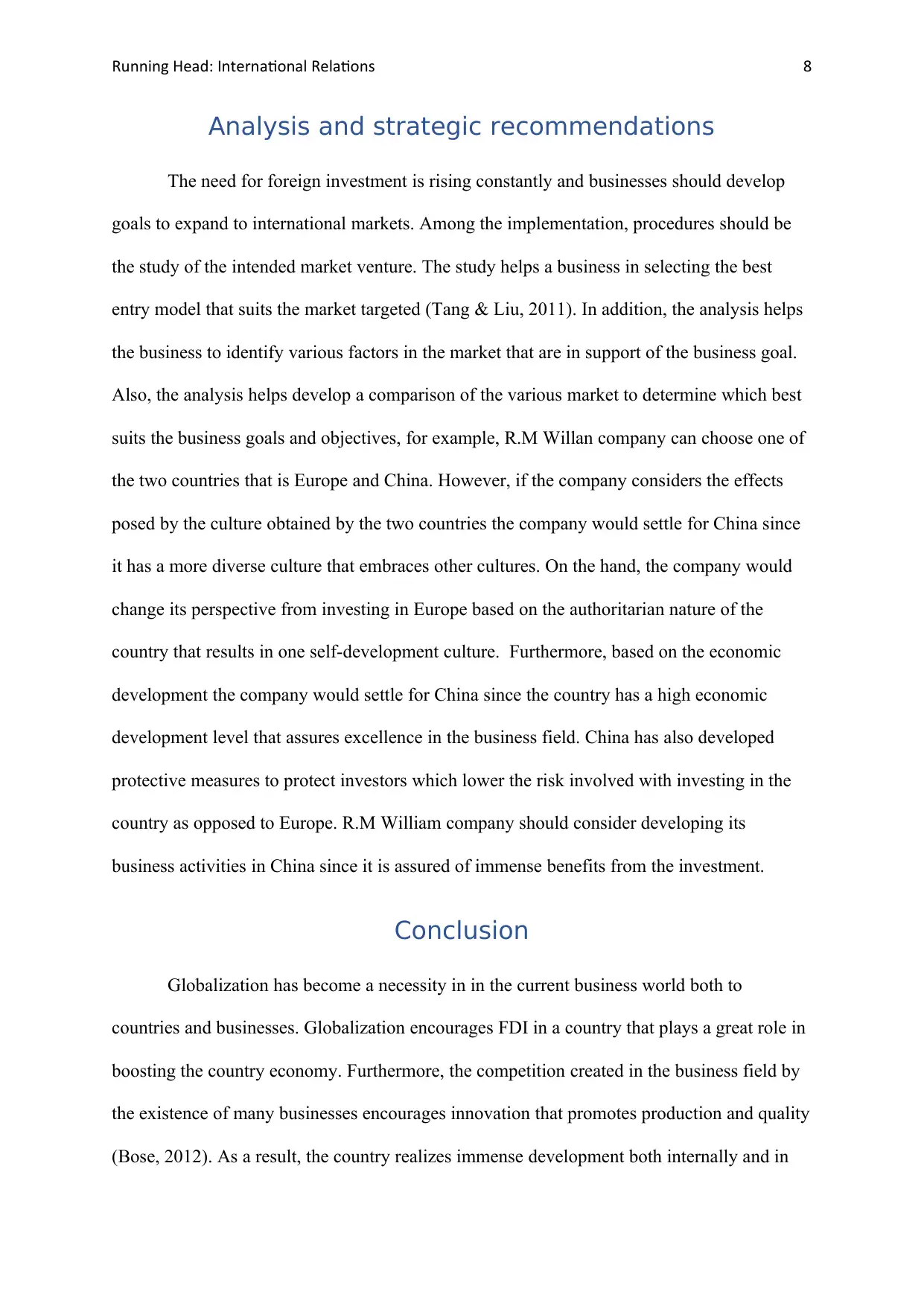
Running Head: International Relations 8
Analysis and strategic recommendations
The need for foreign investment is rising constantly and businesses should develop
goals to expand to international markets. Among the implementation, procedures should be
the study of the intended market venture. The study helps a business in selecting the best
entry model that suits the market targeted (Tang & Liu, 2011). In addition, the analysis helps
the business to identify various factors in the market that are in support of the business goal.
Also, the analysis helps develop a comparison of the various market to determine which best
suits the business goals and objectives, for example, R.M Willan company can choose one of
the two countries that is Europe and China. However, if the company considers the effects
posed by the culture obtained by the two countries the company would settle for China since
it has a more diverse culture that embraces other cultures. On the hand, the company would
change its perspective from investing in Europe based on the authoritarian nature of the
country that results in one self-development culture. Furthermore, based on the economic
development the company would settle for China since the country has a high economic
development level that assures excellence in the business field. China has also developed
protective measures to protect investors which lower the risk involved with investing in the
country as opposed to Europe. R.M William company should consider developing its
business activities in China since it is assured of immense benefits from the investment.
Conclusion
Globalization has become a necessity in in the current business world both to
countries and businesses. Globalization encourages FDI in a country that plays a great role in
boosting the country economy. Furthermore, the competition created in the business field by
the existence of many businesses encourages innovation that promotes production and quality
(Bose, 2012). As a result, the country realizes immense development both internally and in
Analysis and strategic recommendations
The need for foreign investment is rising constantly and businesses should develop
goals to expand to international markets. Among the implementation, procedures should be
the study of the intended market venture. The study helps a business in selecting the best
entry model that suits the market targeted (Tang & Liu, 2011). In addition, the analysis helps
the business to identify various factors in the market that are in support of the business goal.
Also, the analysis helps develop a comparison of the various market to determine which best
suits the business goals and objectives, for example, R.M Willan company can choose one of
the two countries that is Europe and China. However, if the company considers the effects
posed by the culture obtained by the two countries the company would settle for China since
it has a more diverse culture that embraces other cultures. On the hand, the company would
change its perspective from investing in Europe based on the authoritarian nature of the
country that results in one self-development culture. Furthermore, based on the economic
development the company would settle for China since the country has a high economic
development level that assures excellence in the business field. China has also developed
protective measures to protect investors which lower the risk involved with investing in the
country as opposed to Europe. R.M William company should consider developing its
business activities in China since it is assured of immense benefits from the investment.
Conclusion
Globalization has become a necessity in in the current business world both to
countries and businesses. Globalization encourages FDI in a country that plays a great role in
boosting the country economy. Furthermore, the competition created in the business field by
the existence of many businesses encourages innovation that promotes production and quality
(Bose, 2012). As a result, the country realizes immense development both internally and in
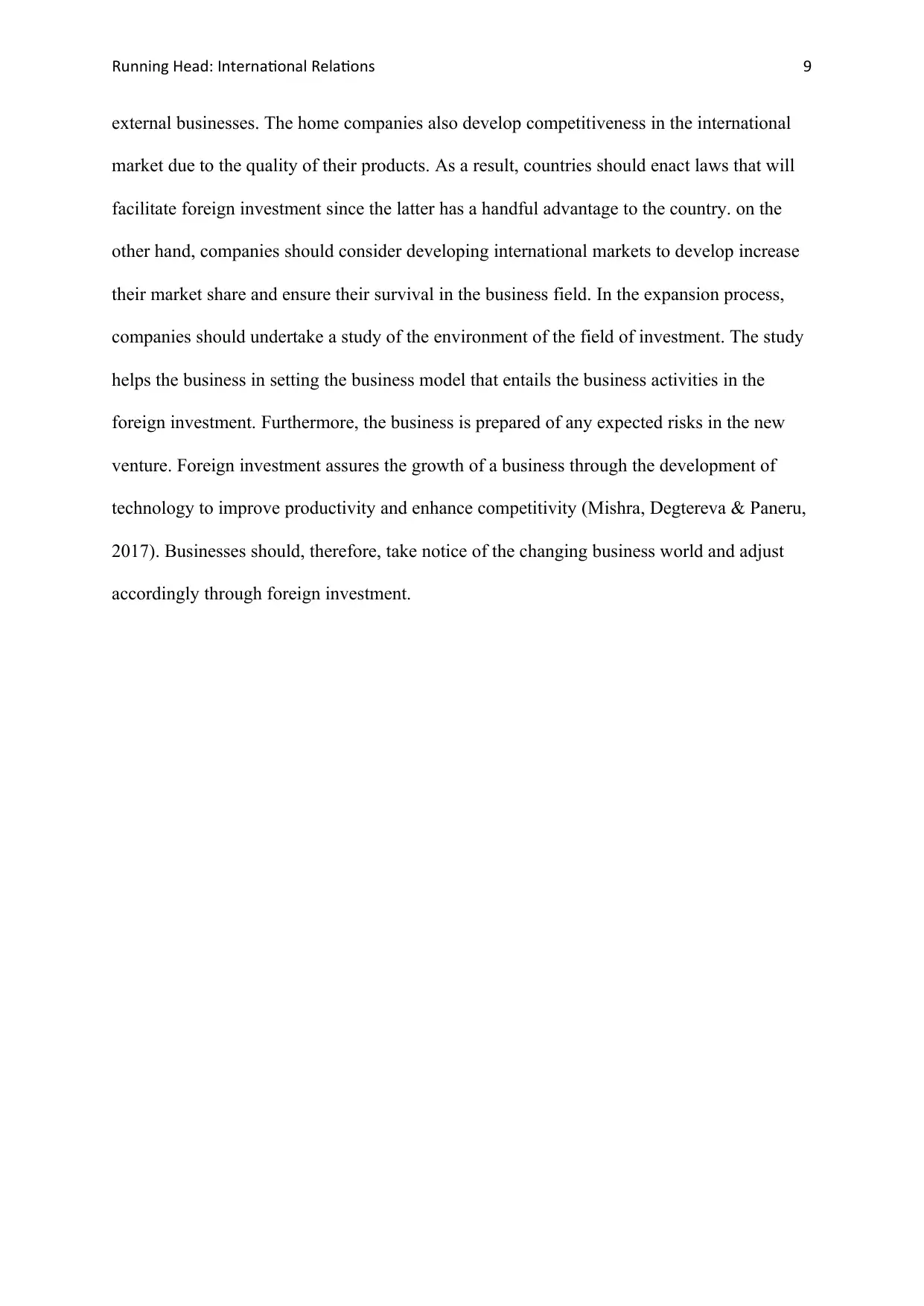
Running Head: International Relations 9
external businesses. The home companies also develop competitiveness in the international
market due to the quality of their products. As a result, countries should enact laws that will
facilitate foreign investment since the latter has a handful advantage to the country. on the
other hand, companies should consider developing international markets to develop increase
their market share and ensure their survival in the business field. In the expansion process,
companies should undertake a study of the environment of the field of investment. The study
helps the business in setting the business model that entails the business activities in the
foreign investment. Furthermore, the business is prepared of any expected risks in the new
venture. Foreign investment assures the growth of a business through the development of
technology to improve productivity and enhance competitivity (Mishra, Degtereva & Paneru,
2017). Businesses should, therefore, take notice of the changing business world and adjust
accordingly through foreign investment.
external businesses. The home companies also develop competitiveness in the international
market due to the quality of their products. As a result, countries should enact laws that will
facilitate foreign investment since the latter has a handful advantage to the country. on the
other hand, companies should consider developing international markets to develop increase
their market share and ensure their survival in the business field. In the expansion process,
companies should undertake a study of the environment of the field of investment. The study
helps the business in setting the business model that entails the business activities in the
foreign investment. Furthermore, the business is prepared of any expected risks in the new
venture. Foreign investment assures the growth of a business through the development of
technology to improve productivity and enhance competitivity (Mishra, Degtereva & Paneru,
2017). Businesses should, therefore, take notice of the changing business world and adjust
accordingly through foreign investment.
⊘ This is a preview!⊘
Do you want full access?
Subscribe today to unlock all pages.

Trusted by 1+ million students worldwide
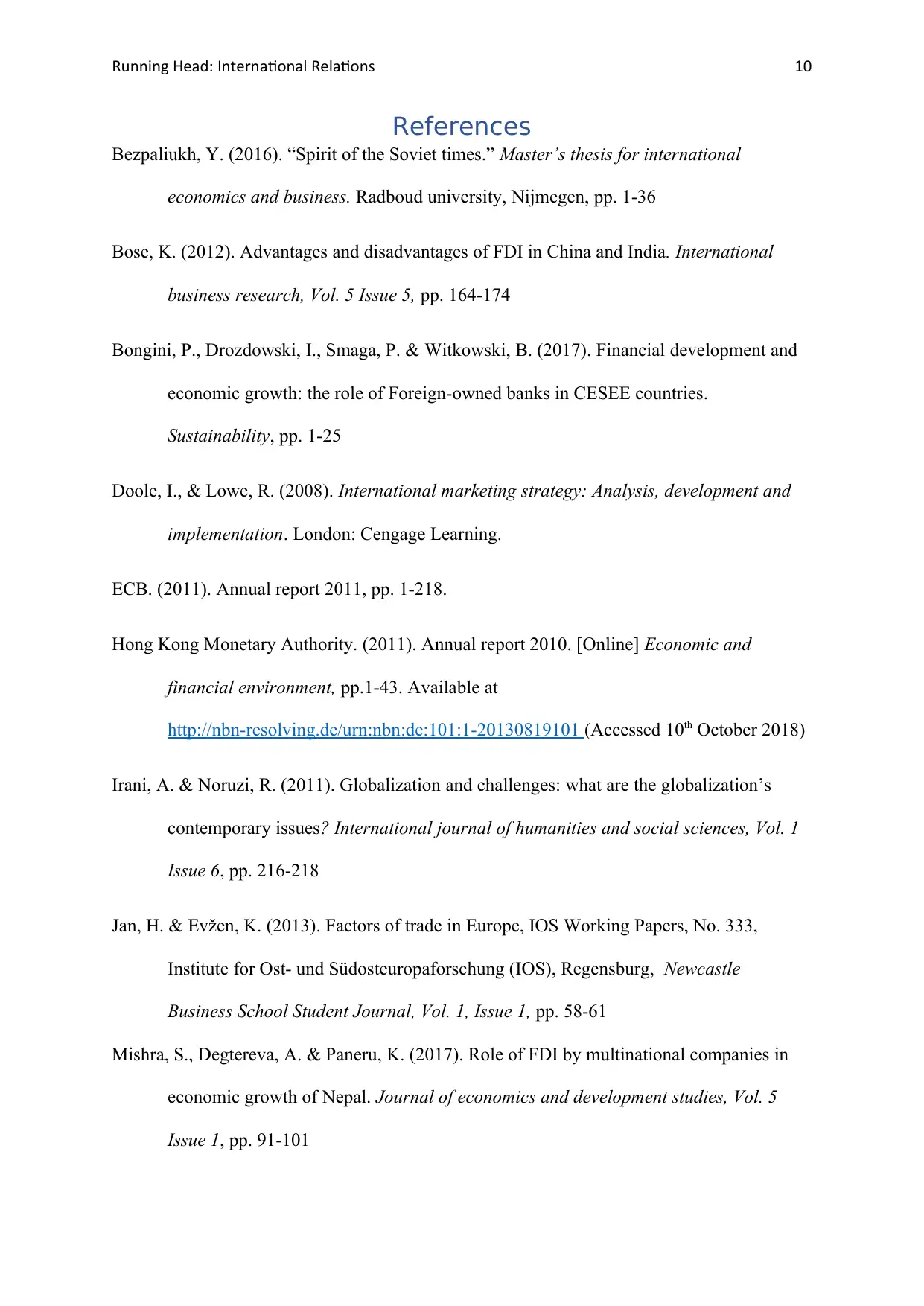
Running Head: International Relations 10
References
Bezpaliukh, Y. (2016). “Spirit of the Soviet times.” Master’s thesis for international
economics and business. Radboud university, Nijmegen, pp. 1-36
Bose, K. (2012). Advantages and disadvantages of FDI in China and India. International
business research, Vol. 5 Issue 5, pp. 164-174
Bongini, P., Drozdowski, I., Smaga, P. & Witkowski, B. (2017). Financial development and
economic growth: the role of Foreign-owned banks in CESEE countries.
Sustainability, pp. 1-25
Doole, I., & Lowe, R. (2008). International marketing strategy: Analysis, development and
implementation. London: Cengage Learning.
ECB. (2011). Annual report 2011, pp. 1-218.
Hong Kong Monetary Authority. (2011). Annual report 2010. [Online] Economic and
financial environment, pp.1-43. Available at
http://nbn-resolving.de/urn:nbn:de:101:1-20130819101 (Accessed 10th October 2018)
Irani, A. & Noruzi, R. (2011). Globalization and challenges: what are the globalization’s
contemporary issues? International journal of humanities and social sciences, Vol. 1
Issue 6, pp. 216-218
Jan, H. & Evžen, K. (2013). Factors of trade in Europe, IOS Working Papers, No. 333,
Institute for Ost- und Südosteuropaforschung (IOS), Regensburg, Newcastle
Business School Student Journal, Vol. 1, Issue 1, pp. 58-61
Mishra, S., Degtereva, A. & Paneru, K. (2017). Role of FDI by multinational companies in
economic growth of Nepal. Journal of economics and development studies, Vol. 5
Issue 1, pp. 91-101
References
Bezpaliukh, Y. (2016). “Spirit of the Soviet times.” Master’s thesis for international
economics and business. Radboud university, Nijmegen, pp. 1-36
Bose, K. (2012). Advantages and disadvantages of FDI in China and India. International
business research, Vol. 5 Issue 5, pp. 164-174
Bongini, P., Drozdowski, I., Smaga, P. & Witkowski, B. (2017). Financial development and
economic growth: the role of Foreign-owned banks in CESEE countries.
Sustainability, pp. 1-25
Doole, I., & Lowe, R. (2008). International marketing strategy: Analysis, development and
implementation. London: Cengage Learning.
ECB. (2011). Annual report 2011, pp. 1-218.
Hong Kong Monetary Authority. (2011). Annual report 2010. [Online] Economic and
financial environment, pp.1-43. Available at
http://nbn-resolving.de/urn:nbn:de:101:1-20130819101 (Accessed 10th October 2018)
Irani, A. & Noruzi, R. (2011). Globalization and challenges: what are the globalization’s
contemporary issues? International journal of humanities and social sciences, Vol. 1
Issue 6, pp. 216-218
Jan, H. & Evžen, K. (2013). Factors of trade in Europe, IOS Working Papers, No. 333,
Institute for Ost- und Südosteuropaforschung (IOS), Regensburg, Newcastle
Business School Student Journal, Vol. 1, Issue 1, pp. 58-61
Mishra, S., Degtereva, A. & Paneru, K. (2017). Role of FDI by multinational companies in
economic growth of Nepal. Journal of economics and development studies, Vol. 5
Issue 1, pp. 91-101
Paraphrase This Document
Need a fresh take? Get an instant paraphrase of this document with our AI Paraphraser
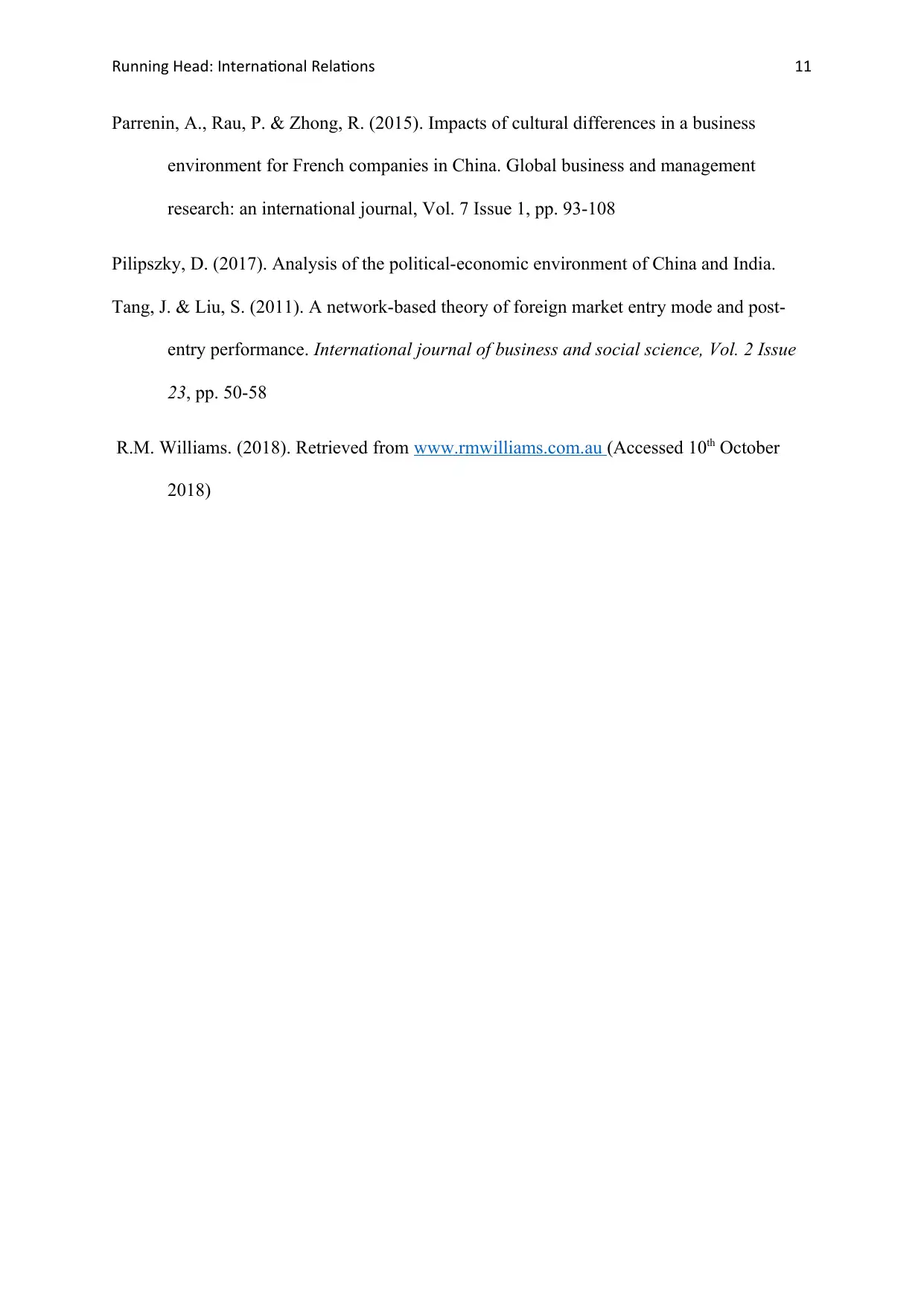
Running Head: International Relations 11
Parrenin, A., Rau, P. & Zhong, R. (2015). Impacts of cultural differences in a business
environment for French companies in China. Global business and management
research: an international journal, Vol. 7 Issue 1, pp. 93-108
Pilipszky, D. (2017). Analysis of the political-economic environment of China and India.
Tang, J. & Liu, S. (2011). A network-based theory of foreign market entry mode and post-
entry performance. International journal of business and social science, Vol. 2 Issue
23, pp. 50-58
R.M. Williams. (2018). Retrieved from www.rmwilliams.com.au (Accessed 10th October
2018)
Parrenin, A., Rau, P. & Zhong, R. (2015). Impacts of cultural differences in a business
environment for French companies in China. Global business and management
research: an international journal, Vol. 7 Issue 1, pp. 93-108
Pilipszky, D. (2017). Analysis of the political-economic environment of China and India.
Tang, J. & Liu, S. (2011). A network-based theory of foreign market entry mode and post-
entry performance. International journal of business and social science, Vol. 2 Issue
23, pp. 50-58
R.M. Williams. (2018). Retrieved from www.rmwilliams.com.au (Accessed 10th October
2018)
1 out of 11
Related Documents
Your All-in-One AI-Powered Toolkit for Academic Success.
+13062052269
info@desklib.com
Available 24*7 on WhatsApp / Email
![[object Object]](/_next/static/media/star-bottom.7253800d.svg)
Unlock your academic potential
Copyright © 2020–2025 A2Z Services. All Rights Reserved. Developed and managed by ZUCOL.




